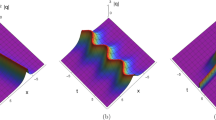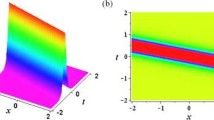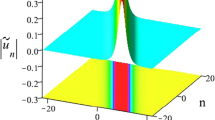Abstract
In this paper, we firstly deduce a reverse space-time Fokas–Lenells equation which can be derived from a rather simple but extremely important symmetry reduction of corresponding local equation. Next, the determinant representations of one-fold Darboux transformation and N-fold Darboux transformation are expressed in detail by special eigenfunctions of spectral problem. Depending on zero seed solution and nonzero seed solution, exact solutions, including bright soliton solutions, kink solutions, periodic solutions, breather solutions, rogue wave solutions and several types of mixed soliton solutions, can be presented. Furthermore, the dynamical behaviors are discussed through some figures. It should be mentioned that the solutions of nonlocal Fokas–Lenells equation possess new characteristics different from the ones of local case. Besides, we also demonstrate the integrability by providing infinitely many conservation laws. The above results provide an alternative possibility to understand physical phenomena in the field of nonlinear optics and related fields.




Similar content being viewed by others
Data availability
The authors declare that all data generated or analyzed during this study are included in this article.
References
Fokas, A.S.: On a class of physically important integrable equations. Phys. D 87(1–4), 145–150 (1995)
Lenells, J.: Exactly solvable model for nonlinear pulse propagation in optical fibers. Stud. Appl. Math. 123(2), 215–232 (2009)
Lenells, J., Fokas, A.S.: On a novel integrable generalization of the nonlinear Schrödinger equation. Nonlinearity 22(1), 11–27 (2009)
Lenells, J.: Dressing for a novel integrable generalization of the nonlinear Schrödinger equation. J. Nonlinear Sci. 20(6), 709–722 (2010)
Vekslerchik, V.E.: Lattice representation and dark solitons of the Fokas-Lenells equation. Nonlinearity 24(4), 1165–1175 (2011)
Lü, X., Peng, M.S.: Nonautonomous motion study on accelerated and decelerated solitons for the variable-coefficient Lenells-Fokas model. Chaos 23(1), 013122 (2013)
Matsuno, Y.: A direct method of solution for the Fokas-Lenells derivative nonlinear Schrödinger equation: I Bright soliton solutions. J. Phys. A 45(23), 235202 (2012)
Matsuno, Y.: A direct method of solution for the Fokas-Lenells derivative nonlinear Schrödinger equation: II Dark soliton solutions. J. Phys. A 45(47), 475202 (2012)
He, J.S., Xu, S.W., Porsezian, K.: Rogue waves of the Fokas-Lenells equation. J. Phys. Soc. Japan 81(12), 124007 (2012)
Xu, S.W., He, J.S., Cheng, Y., Porsezian, K.: The n-order rogue waves of Fokas-Lenells equation. Math. Meth. Appl. Sci. 38(6), 1106–1126 (2015)
Xu, J., Fan, E.G.: Long-time asymptotics for the Fokas-Lenells equation with decaying initial value problem: without solitons. J. Differ. Equ. 259(3), 1098–1148 (2015)
Wang, B., Zhang, Z., Li, B.: Two types of smooth positons for nonlocal Fokas-Lenells equation. Int. J. Mod. Phys. B 34(17), 2050148 (2020)
Hanif, Y., Sarfraz, H., Saleem, U.: Dynamics of loop soliton solutions of PT symmetric nonlocal short pulse equation. Nonlinear Dyn. 100(2), 1559–1569 (2020)
Song, C.Q., Zhu, Z.N.: An integrable reverse space-time nonlocal Sasa-Satsuma equation. Acta Phys. Sin.-Ch Ed 69(1), 010204 (2020)
Hanif, Y., Saleem, U.: Broken and unbroken PT-symmetric solutions of semi-discrete nonlocal nonlinear Schrödinger equation. Nonlinear Dyn. 98(1), 233–244 (2019)
Yang, B., Yang, J.K.: Rogue waves in the nonlocal PT-symmetric nonlinear Schrödinger equation. Lett. Math. Phys. 109(4), 945–973 (2019)
Wazwaz, A.M.: A new integrable nonlocal modified KdV equation: abundant solutions with distinct physical structures. J. Ocean Eng. Sci. 2(1), 1–4 (2017)
Ji, J.L., Zhu, Z.N.: Soliton solutions of an integrable nonlocal modified Korteweg-de Vries equation through inverse scattering transform. J. Math. Anal. Appl. 453(2), 973–984 (2017)
Wazwaz, A.M.: On the nonlocal Boussinesq equation: multiple-soliton solutions. Appl. Math. Lett. 26(11), 1094–1098 (2013)
Li, H.M., Tian, B., Xie, X.Y., Chai, J., Liu, L., Gao, Y.T.: Soliton and rogue-wave solutions for a (2+1)-dimensional fourth-order nonlinear Schrödinger equation in a Heisenberg ferromagnetic spin chain. Nonlinear Dyn. 86(1), 369–380 (2016)
Bender, C.M., Boettcher, S.: Real spectra in non-Hermitian Hamiltonians having PT symmetry. Phys. Rev. Lett. 80(24), 5243–5246 (1998)
Bender, C.M., Boettcher, S., Meisinger, P.N.: PT-symmetric quantum mechanics. J. Math. Phys. 40(5), 2201–2229 (1999)
Ablowitz, M.J., Musslimani, Z.H.: Integrable nonlocal nonlinear Schrödinger equation. Phys. Rev. Lett. 110, 064105 (2013)
Yan, Z.Y.: Integrable PT-symmetric local and nonlocal vector nonlinear Schrödinger equations: a unified two-parameter model. Appl. Math. Lett. 47, 61–68 (2015)
Fokas, A.S.: Integrable multidimensional versions of the nonlocal nonlinear Schrödinger equation. Nonlinearity 29, 319–324 (2016)
Ablowitz, M.J., Musslimani, Z.H.: Integrable nonlocal nonlinear equations. Stud. Appl. Math. 139, 7–59 (2016)
Lou, S.Y., Huang, F.: Alice-Bob physics: coherent solutions of nonlocal KdV systems. Sci. Rep. 7, 869 (2017)
Hu, X.R., Chen, Y.: Nonlocal symmetries, consistent Riccati expansion integrability, and their applications of the (2+1)-dimensional Broer-Kaup-Kupershmidt system. Chin. Phys. B 24(9), 090203 (2015)
Li, M., Zhang, Y., Ye, R.S., Lou, Y.: Exact solutions of the nonlocal Gerdjikov-Ivanov equation. Commun. Theor. Phys. 73(10), 105005 (2021)
Ruschhaupt, A., Delgado, F., Muga, J.G.: Physical realization of PT-symmetric potential scattering in a planar slab waveguide. J. Phys. A Math. Gen. 38(9), L171–L176 (2005)
Cartarius, H., Wunner, G.: Model of a PT-symmetric Bose-Einstein condensate in a delta-function double-well potential. Phys. Rev. A 86(1), 013612 (2012)
Gadzhimuradov, T.A., Agalarov, A.M.: Towards a gauge-equivalent magnetic structure of the nonlocal nonlinear Schrödinger equation. Phys. Rev. A 93(6), 062124 (2016)
Schindler, J., Li, A., Zheng, M.C., Ellis, F.M., Kottos, T.: Experimental study of active LRC circuits with PT symmetries. Phys. Rev. A 84(4), 040101 (2011)
Bender, C.M., Berntson, B.K., Parker, D., Samuel, E.: Observation of PT phase transition in a simple mechanical system. Am. J. Phys. 81(3), 173–179 (2013)
Zhang, R.F., Bilige, S.: Bilinear neural network method to obtain the exact analytical solutions of nonlinear partial differential equations and its application to p-gBKP equation. Nonlinear Dyn. 95, 3041–3048 (2019)
Zhang, R.F., Bilige, S., Liu, J.G., Li, M.C.: Bright-dark solitons and interaction phenomenon for p-gBKP equation by using bilinear neural network method. Phys. Scr. 96, 025224 (2021)
Zhang, R.F., Bilige, S., Chaolu, T.: Fractal solitons, arbitrary function solutions, exact periodic wave and breathers for a nonlinear partial differential equation by using bilinear neural network method. J. Syst. Sci. Complex. 34, 122–139 (2021)
Hu, C.C., Tian, B., Zhao, X.: Rogue and lump waves for the (3+1)-dimensional Yu-Toda-Sasa-Fukuyama equation in a liquid or lattice. Int. J. Mod. Phys. B (2021)
Hu, C.C., Tian, B., Qu, Q.X., Yang, D.Y.: The higher-order and multi-lump waves for a (3+1)-dimensional generalized variable-coefficient shallow water wave equation in a fluid. Chinese J. Phys. (2021)
Wen, X.Y., Wang, H.T.: Breathing-soliton and singular rogue wave solutions for a discrete nonlocal coupled Ablowitz-Ladik equation of reverse-space type. Appl. Math. Lett. 111, 106683 (2021)
Yang, B., Chen, Y.: Several reverse-time integrable nonlocal nonlinear equations: Rogue-wave solutions. Chaos 28(5), 053104 (2018)
Meng, X.H., Wen, X.Y., Piao, L.H., Wang, D.S.: Determinant solutions and asymptotic state analysis for an integrable model of transient stimulated Raman scattering. Optik 200, 163348 (2020)
Guo, R., Liu, Y.F., Hao, H.Q., Qi, F.H.: Coherently coupled solitons, breathers and rogue waves for polarized optical waves in an isotropic medium. Nonlinear Dyn. 80(3), 1221–1230 (2015)
Li, N.N., Guo, R.: Nonlocal continuous Hirota equation: Darboux transformation and symmetry broken and unbroken soliton solutions. Nonlinear Dyn. 105, 617–628 (2021)
Guo, R., Tian, B., Wang, L.: Soliton solutions for the reduced Maxwell-Bloch system in nonlinear optics via the N-fold Darboux transformation. Nonlinear Dyn. 69(4), 2009–2020 (2012)
Chen, S.S., Tian, B., Qu, Q.X., Li, H., Sun, Y., Du, X.X.: Alfvén solitons and generalized Darboux transformation for a variable-coefficient derivative nonlinear Schrödinger equation in an inhomogeneous plasma. Chaos Solitons Fractals 148, 111029 (2021)
Chen, S.S., Tian, B., Zhang, C.R.: Odd-fold Darboux transformation, breather, rogue-wave and semirational solutions on the periodic background for a variable-coefficient derivative nonlinear Schrödinger equation in an inhomogeneous plasma. Ann. Phys. 2100231 (2021)
Shen, J.L., Wu, X.Y.: Periodic-soliton and periodic-type solutions of the (3+1)-dimensional Boiti-Leon-Manna-Pempinelli equation by using BNNM. Nonlinear Dyn. 106, 831–840 (2021)
Zhang, R.F., Li, M.C., Yin, H.M.: Rogue wave solutions and the bright and dark solitons of the (3+1)-dimensional Jimbo-Miwa equation. Nonlinear Dyn. 103, 1071–1079 (2021)
Zhang, R.F., Li, M.C., Albishari, M., Zheng, F.C., Lan, Z.Z.: Generalized lump solutions, classical lump solutions and rogue waves of the (2+1)-dimensional Caudrey-Dodd-Gibbon-Kotera-Sawada-like equation. Appl. Math. Comput. 403, 126201 (2021)
Zhang, Q.Y., Zhang, Y., Ye, R.: Exact solutions of nonlocal Fokas-Lenells equation. Appl. Math. Lett. 98, 336–343 (2019)
Imai, K.: Generalization of the Kaup-Newell inverse scattering formulation and Darboux transformation. J. Phys. Soc. Japan 68(2), 355–359 (1999)
Ma, Y.C.: The perturbed plane-wave solution of the cubic Schrödinger equation. Stud. Appl. Math. 60, 43–58 (1979)
Zhang, Y., Yang, J.W., Chow, K.W., Wu, C.F.: Solitons, breathers and rogue waves for the coupled Fokas-Lenells system via Darboux transformation. Nonlinear Anal. RWA 33, 237–252 (2017)
Akhmediev, N.N., Eleonskii, V.M., Kulagin, N.E.: Exact first-order solutions of the nonlinear Schrödinger equation. Theor. Math. Phys. 72, 809–818 (1987)
Zuo, D.W., Gao, Y.T., Feng, Y.J., Xue, L.: Rogue-wave interaction for a higher-order nonlinear Schrödinger-Maxwell-Bloch system in the optical-fiber communication. Nonlinear Dyn. 78(4), 2309–2318 (2014)
Acknowledgements
This work has been supported by the National Natural Science Foundation of China under Grant No. 11771111.
Author information
Authors and Affiliations
Corresponding author
Ethics declarations
Conflict of interest
The authors declare that they have no conflict of interest.
Additional information
Publisher's Note
Springer Nature remains neutral with regard to jurisdictional claims in published maps and institutional affiliations.
This work has been supported by the National Natural Science Foundation of China (NNSFC) under Grant No. 11771111.
Appendices
Appendix A
From Eq. (2.5a), comparing the coefficients of \(\lambda ^{j}, j=3, 2, 1, 0, -1\), we can get
Similarly, from Eq. (2.5b), comparing the coefficients of \(\lambda ^{j}, j=2, 1, 0, -1, -2, -3\) under the condition \(b_{1}=0, c_{1}=0\), we can get
Appendix B
The \(a_{1}, d_{1}, b_{0}, c_{0}\) for one-fold Darboux matrix \(T^{[1]}\) yield
In other words, we can deduce
Appendix C
The \(W^{[N]}, \widetilde{T^{[N]}_{11}}, \widetilde{T^{[N]}_{12}}, \widetilde{W^{[N]}}, \widetilde{T^{[N]}_{21}}, \widetilde{T^{[N]}_{22}}\) for N-fold Darboux matrix \(T^{[N]}\) read
Appendix D
The \(\varOmega _{-(N-1)}, \widetilde{\varOmega _{-(N-1)}}\) for N-soliton solutions (\(q^{[N]}, q^{[N]}(-x, -t)\)) arrive at
Rights and permissions
About this article
Cite this article
Song, JY., Xiao, Y. & Zhang, CP. Darboux transformation, exact solutions and conservation laws for the reverse space-time Fokas–Lenells equation. Nonlinear Dyn 107, 3805–3818 (2022). https://doi.org/10.1007/s11071-021-07170-z
Received:
Accepted:
Published:
Issue Date:
DOI: https://doi.org/10.1007/s11071-021-07170-z




